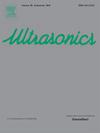Dual-frequency excitation in high-frame-rate ultrasonic backscatter coefficient analysis of hemorheological properties
IF 3.8
2区 物理与天体物理
Q1 ACOUSTICS
引用次数: 0
Abstract
Hemorheological properties, such as erythrocyte aggregation can be assessed by ultrasonic backscatter coefficient analysis. In this study, a data-acquisition sequence with dual-frequency (dual-f) excitation was proposed to expand the ultrasonic frequency bandwidth with high-frame-rate imaging. The approach was experimentally validated using ex vivo porcine blood measurements and in vivo human imaging. The center frequency of the excitation wave was alternated between 7.8 (f1) and 12.5 (f2) MHz in the frequency spectral analysis using the reference phantom method. The frequency spectra revealed that the dual-f sequence achieved a bandwidth of 4.5–15 MHz at −20 dB, almost equivalent to those achieved with conventional single-frequency excitation (5.0–15 MHz) with a short-duration wave at 10 MHz (mono-f) in reference media with the sufficient condition of signal-to-noise ratio. The aggregation and disaggregation states of porcine blood suspended in high-molecular-weight dextran were determined by the isotropic diameter and packing factor using the structure factor size estimator. The discrimination performance of the dual-f approach increased, owing to the broadband frequency responses, in contrast with the limited performance of mono-f due to a low signal-to-noise ratio. This approach incorporating dual-f sequence is beneficial for obtaining robustly frequency spectra of hemorheological properties from in vivo scenarios.
求助全文
约1分钟内获得全文
求助全文
来源期刊

Ultrasonics
医学-核医学
CiteScore
7.60
自引率
19.00%
发文量
186
审稿时长
3.9 months
期刊介绍:
Ultrasonics is the only internationally established journal which covers the entire field of ultrasound research and technology and all its many applications. Ultrasonics contains a variety of sections to keep readers fully informed and up-to-date on the whole spectrum of research and development throughout the world. Ultrasonics publishes papers of exceptional quality and of relevance to both academia and industry. Manuscripts in which ultrasonics is a central issue and not simply an incidental tool or minor issue, are welcomed.
As well as top quality original research papers and review articles by world renowned experts, Ultrasonics also regularly features short communications, a calendar of forthcoming events and special issues dedicated to topical subjects.
 求助内容:
求助内容: 应助结果提醒方式:
应助结果提醒方式:


